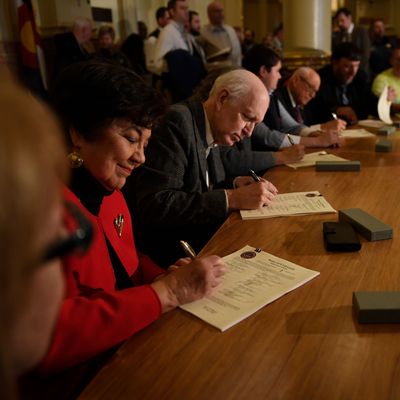
A crucial part of the process of ratifying the 2020 presidential election is occurring today, as members of the Electoral College previously certified as representing the winning candidate in each state formally cast their ballots. This mostly happens at state capitals, though three states (Colorado, Nevada, and Utah) have virtual votes. But the big moment occurred at 5:30 p.m. ET, when California’s 55 electoral votes went to Joe Biden giving him more than the 270 necessary to become president.
Biden declared victory — again.
Given the claims of the Trump campaign and Trump supporters that the president actually won by a landslide in various states carried by Biden, there have been legitimate fears of angry protests against these pro forma Electoral College proceedings. Threats of violence were credible enough in Michigan that state legislative offices were closed in Lansing until the 2 p.m. vote there had taken place. And one Michigan Republican legislator was actually stripped of his committee assignments by the GOP leadership after he publicly refused to rule out violence in protests against the Electoral College vote.
As the Electoral College repudiations rolled in, Team Trump unveiled a new wrinkle in its strategy to overturn the election. Trump adviser Stephen Miller told Fox & Friends that “alternative electors” pledged to the president would “vote” today in Georgia, Pennsylvania, and Wisconsin.
And sure enough, as the hardline pro-Trump Epoch Times reported, Trump-selected would-be electors gathered in those three states and in Arizona to cast what one called “conditional” Electoral College votes for the president. That sounds better than “imaginary.”
The idea here is that in theory Trump slates could be recognized either by some future action in the courts (though his campaign has pretty much exhausted its legal remedies after the abrupt dismissal of the Texas lawsuit by the U.S. Supreme Court late last week) or by Congress when it meets to formally count electoral votes on January 6. As election-law expert Rick Hasen notes: “These [alternative] electors have neither been certified by state executives nor purportedly appointed by state legislators. They don’t have legal authority and so this does not affect the counting of Electoral College votes.” But presumably the existence of these bizarro electors will give Republicans planning a symbolic vote to invalidate the election on January 6 something to point toward. And it would not be particularly surprising if the Trump campaign puts pressure on Vice-President Mike Pence, who will be required to “announce” the electoral vote on January 6, to give Trump’s “alternative” electors some sort of official recognition before the final vote.
So we proceed with two parallel elections taking place: a fake election conducted by the Trump campaign without any legal authority, and the real election that is leading inexorably to Joe Biden’s inauguration on January 20, 2021.






























